Hytera Communications RD62XIU2 Digital Wall-mounted Repeater User Manual
Hytera Communications Corporation Limited Digital Wall-mounted Repeater
User manual
Preface
Thanks for your favor in our product. To derive optimum performance from the product, please read this
manual and the Safety Information Booklet carefully before use.

Instructional Icons
Caution: Indicates situations that could cause damage to your product or bodily injury.
Note: Indicates tips that can help you make better use of your product.
Term Explanation
Voltage Standing Wave Ratio (VSWR)
Voltage Standing Wave Ratio (VSWR) is a value that measures how well a load is impedance-matched
to a source.
Copyright Information
Hytera is the trademark or registered trademark of Hytera Communications Corporation Limited (the Company) in
the People's Republic of China (PRC) and/or other countries or areas. The Company retains the ownership of its
trademarks and product names. All other trademarks and/or product names that may be used in this manual are
properties of their respective owners.
The product described in this manual may include the Company's computer programs stored in memory or other
media. Laws in PRC and/or other countries or areas protect the exclusive rights of the Company with respect to its
computer programs. The purchase of this product shall not be deemed to grant, either directly or by implication, any
rights to the purchaser regarding the Company's computer programs. The Company's computer programs may not
be copied, modified, distributed, decompiled, or reverse-engineered in any manner without the prior written consent
of the Company.
Disclaimer
The Company endeavors to achieve the accuracy and completeness of this manual, but no warranty of accuracy or
reliability is given. All the specifications and designs are subject to change without notice due to continuous
technological development. No part of this manual may be copied, modified, translated, or distributed in any
manner without the prior written consent of the Company.
We do not guarantee, for any particular purpose, the accuracy, validity, timeliness, legitimacy or completeness of
the third-party products and contents involved in this manual.
If you have any suggestions or would like to receive more information, please visit our website at:
http://www.hytera.com.
FCC Statement
This equipment has been tested and found to comply with the limits for a Class B digital device, pursuant to part 15
of FCC Rules. These limits are designed to provide reasonable protection against harmful interference in a
residential installation. This equipment generates and can radiate radio frequency energy. If not installed and used in
accordance with the instructions, it may cause harmful interference to radio communications. However, there is no
guarantee that interference will not occur in a particular installation. Verification of harmful interference by this
equipment to radio or television reception can be determined by turning it off and then on. The user is encouraged to
try to correct the interference by one or more of the following measures:
Reorient or relocate the receiving antenna. Increase the separation between the equipment and receiver.
Connect the equipment into an outlet on a different circuit to that of the receiver's outlet.
Consult the dealer or an experienced radio/TV technician for help.
50cm
5dBi
50%.
and 2.1091
Operation is subject to the following two conditions:
This device may not cause harmful interference.
This device must accept any interference received, including interference that may cause undesired operation.
Note: Changes or modifications to this unit not expressly approved by the party responsible for compliance could
void the user's authority to operate the equipment.
Compliance with RF Exposure Standards
Hytera's radio complies with the following RF energy exposure standards and guidelines:
United States Federal Communications Commission, Code of Federal Regulations; 47 CFR § 1.1307, 1.1310
American National Standards Institute (ANSI) / Institute of Electrical and Electronic Engineers
(IEEE) C95. 1:2005; Canada RSS102 Issue 5 March 2015
Institute of Electrical and Electronic Engineers (IEEE) C95.1:2005 Edition
OperationalInstructionsandTrainingGuidelines
Toensuretheoptimalperformanceandthecompliancewithoccupational/controlled
environmentRFradiancelimitsintheabovestandards,pleaseadheretothefollowing
requirements:
● Whenyouareinstallingtheproductantennaoutside,setuptheantennaaccordingtothe
supplier’srequirementswithitsGainwithin andkeepitatleast away
fromhumanbody.
● Notuseddutycycleover
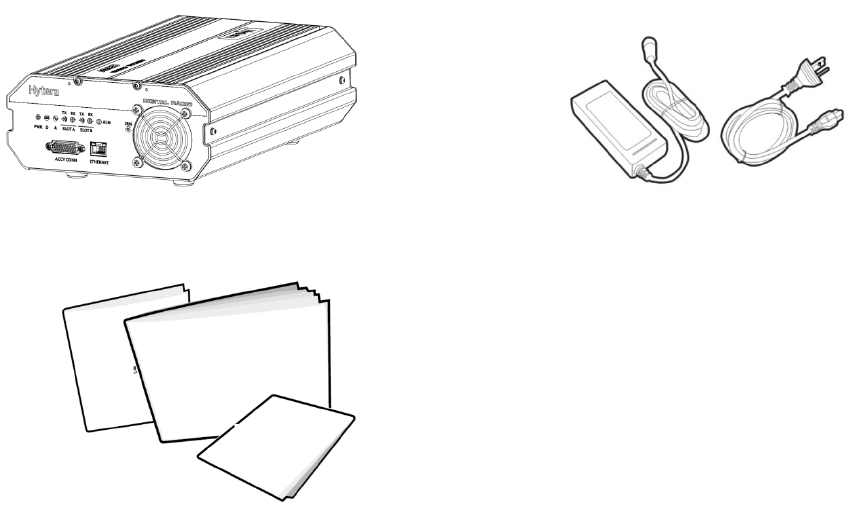
1. Checking Items in the Package
Please unpack carefully and check that all items listed below are received. If any item is missing or
damaged, please contact your dealer.
Repeater AC Power Cord
Documentation Kit
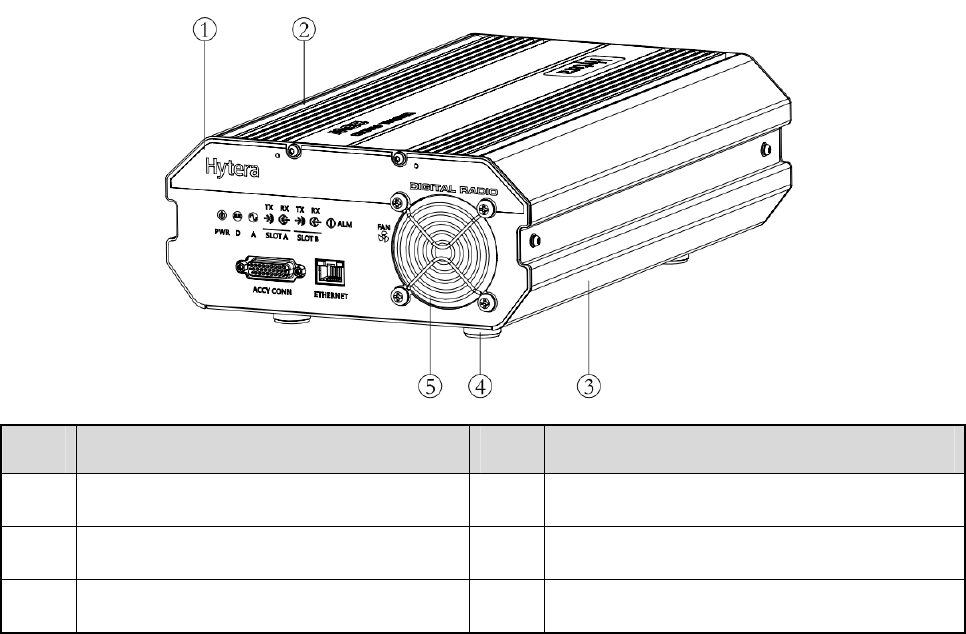
2. Product Introduction
2.1 Parts
No. Part Name No. Part Name
1 Front Panel 4 Foot Pad
2 Upper Cover 5 Fan Mesh Enclosure
3 Chassis / /
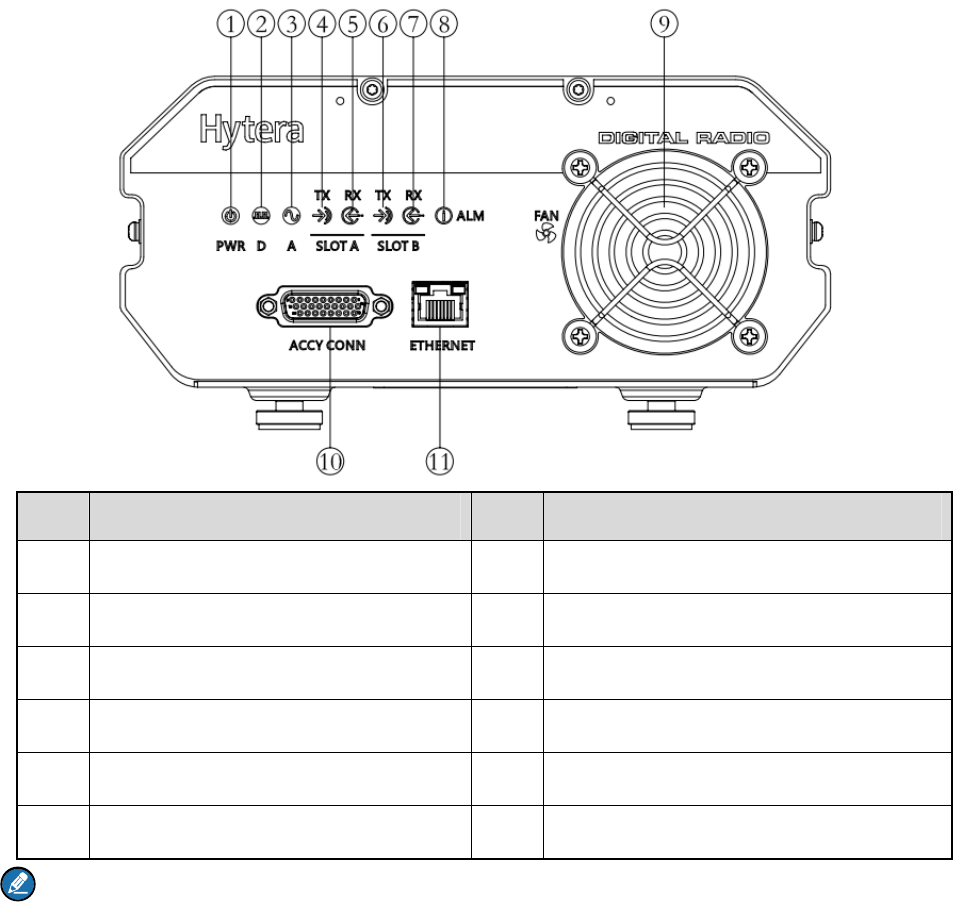
2.2 Front Panel
No. Part Name No. Part Name
1 Power Indicator 7 Slot B RX Indicator
2 Digital Mode Indicator 8 Alarm Indicator
3 Analog Mode Indicator 9 Fan Inlet
4 Slot A TX Indicator 10 D-SUB Data Interface
5 Slot A RX Indicator 11 RJ45 Data Interface
6 Slot B TX Indicator / /
Note:
If the repeater is manufactured without internal duplexer, then part 8 will be an external duplexer RX
port; if it is manufactured with internal duplexer, then there is no connection inside part 8.
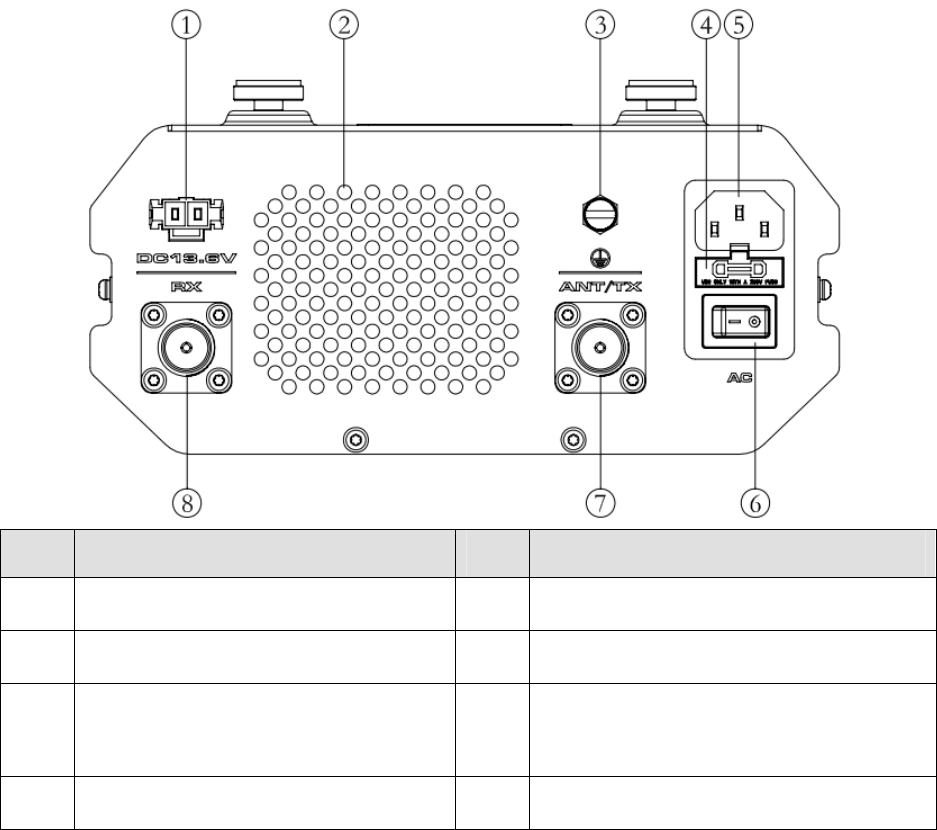
2.3 Rear Panel
No. Part Name No. Part Name
1 DC Power Inlet 5 AC Power Inlet
2 Fan Outlet 6 AC Power Switch
3 Ground Terminal 7 ANT/TX Antenna Connector (N-type
Female)
4 Fuse Box 8 RX Antenna Connector (N-type Female)
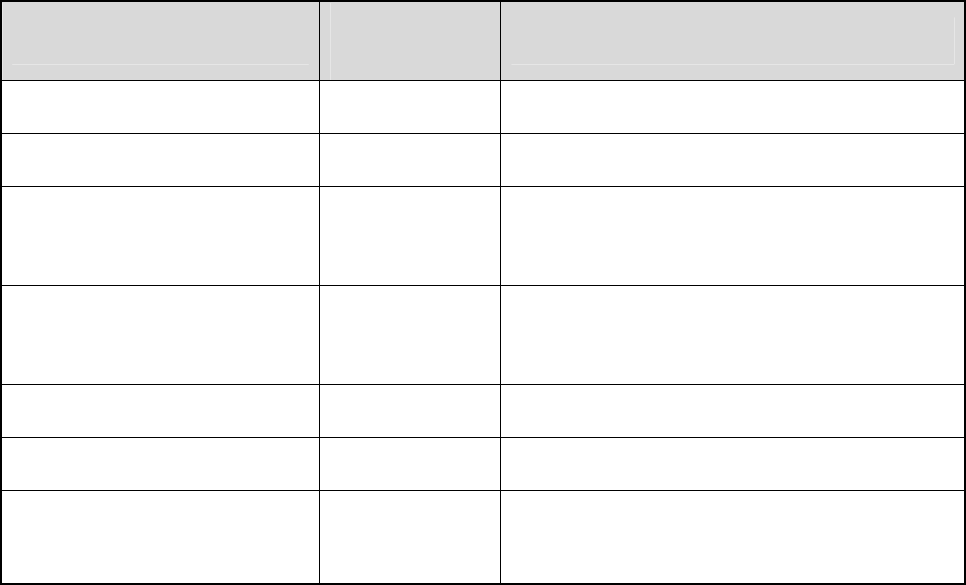
3. Status Indication
LED indicators on the front panel indicate the following repeater status:
LED Indicator Name LED Indicator
Status Repeater Status
Digital Mode Indicator Blue The repeater is operating in digital mode.
Analog Mode Indicator Yellow The repeater is operating in analog mode.
Slot A TX Indicator Red
z Analog Mode: The repeater is transmitting.
z Digital Mode: Slot A is transmitting.
Slot A RX Indicator Green
z Analog Mode: The repeater is receiving.
z Digital Mode: Slot A is receiving.
Slot B TX Indicator Red Digital Mode: Slot B is transmitting.
Slot B RX Indicator Green Digital Mode: Slot B is receiving.
Alarm Indicator Red Alarm alert indication will remain until all alarms
are eliminated.
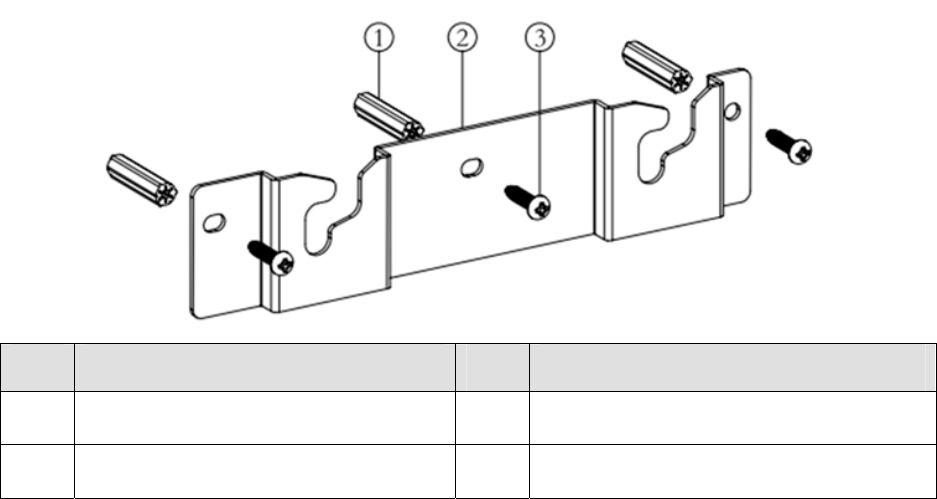
4. Before Use
4.1 Instruction
To ensure optimum performance and reliability of the repeater, please read the following instructions
carefully.
Operation Environment
The repeater must be installed in a dry and well-ventilated place with ambient temperature of -30 ℃ to
+60℃ and relative humidity of not more than 95%.
Voltage Check
Check whether the input voltage is within the operating voltage of the repeater (DC power supply: 13.6V
±15%; AC power supply: 90V to 264V).
4.2 Wall-mount Bracket Installation (Optional)
Please contact your dealer to purchase a wall-mount bracket kit to install the repeater on the wall.
No. Part Name No. Part Name
1 Expansion Rubber Plug 3 Self-tapping Screw
2 Wall-mount Bracket / /
4.2.1 Installation Tools
Tools required for installing the repeater include an electric drill and a T10 torx screwdriver.
4.2.2 Installation Steps
Step 1 To install the wall-mount bracket, do as follows:
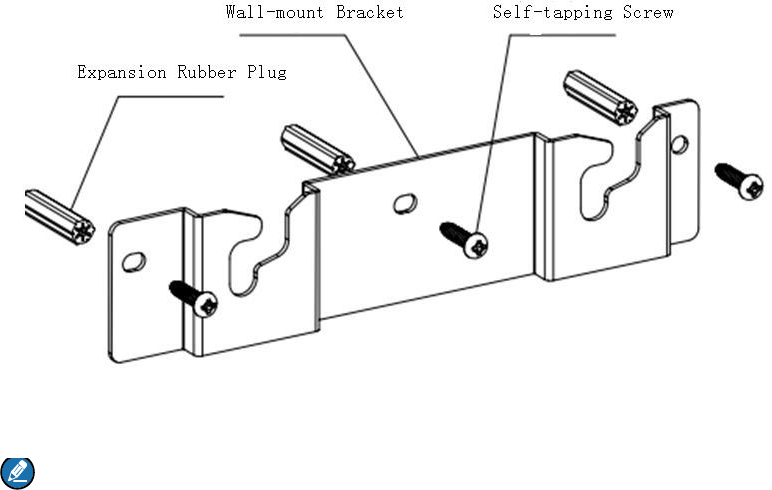
1. Use the electric drill to drill three holes on the wall which align with that on the wall-mount
bracket;
2. Put the expansion rubber plug into the drill holes; you can ignore this step if the wall is not a
concrete wall;
3. Use three ST4X16 self-tapping screws to fasten the bracket on the wall.
Note: Make sure the wall can support the repeater’s weight before drilling.
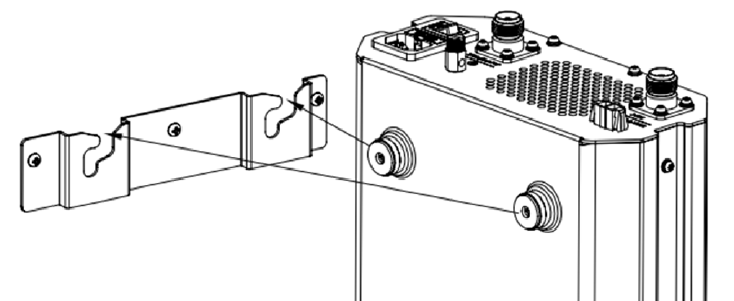
Step 2 To amount the repeater on the bracket, do as follows:
1. Align the hanging screws on the upper side of the repeater with the notch of the bracket and
hang the repeater on the bracket;
2. Move the repeater side to side slightly to ensure the hanging screws reach the bottom of the
notch.
4.2.3 Product Check
Please check whether the repeater works properly by observing the 7 LEDs located in the front panel
after the repeater is powered on via the AC Power Switch key.
5. Basic Operation
5.1 Powering On/Off
Powering On/Off Manually
To power on, long press the AC Power Switch after connecting the power supply with
the power adapter.
To power off, long press the AC Power Switch.
Auto Power On
If the power of the adapter happens to be cut off or the power adapter runs out of the
battery power when in use, the repeater will be powered off forcibly. After that, when the
power adapter restarts to supply power, the repeater will power on automatically.
The Auto Power on feature is set via the programming software by the dealer.
5.2 Adjusting the Power Level
You can request your dealer to set the TX power to High or Low. High power can extend
the repeater coverage, enabling you to communicate with farther radios.
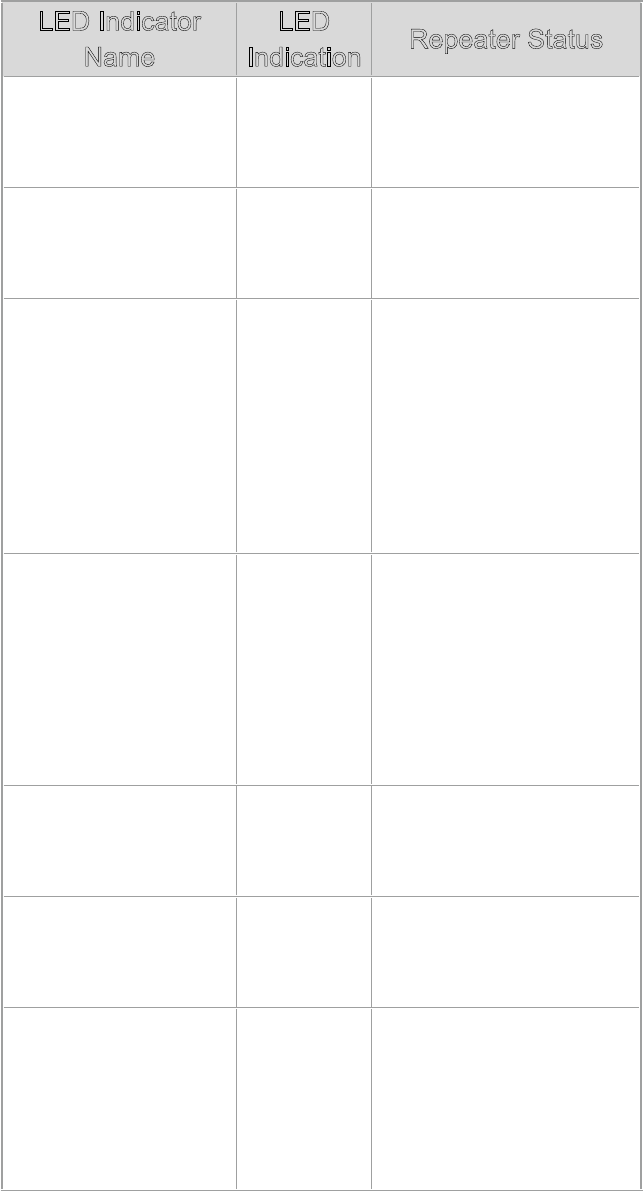
The LED indicators on the front panel indicate the
following repeating status:
LED Indicator
Name
LED
Indication Repeater Status
Digital Mode LED
Indicator Blue
The repeater is
operating in digital
mode.
Analog Mode LED
Indicator Yellow
The repeater is
operating in analog
mode.
Slot A TX LED
Indicator Red
●Analog mode:
The repeater is
transmitting.
●Digital mode:
The repeater is
transmitting in Slot
A.
Slot A RX LED
Indicator Green
●Analog mode:
The repeater is
receiving.
●Digital mode:
The repeater is
receiving in Slot A.
Slot B TX LED
Indicator Red
Digital mode:
The repeater is
transmitting in Slot B.
Slot B RX LED
Indicator Green
Digital Mode: The
repeater is receiving
in Slot B.
Alarm LED
Indicator Red
Alarm occurs. The
alarm LED indicator
will remain red
until all alarms are
eliminated.
6. Status Indication
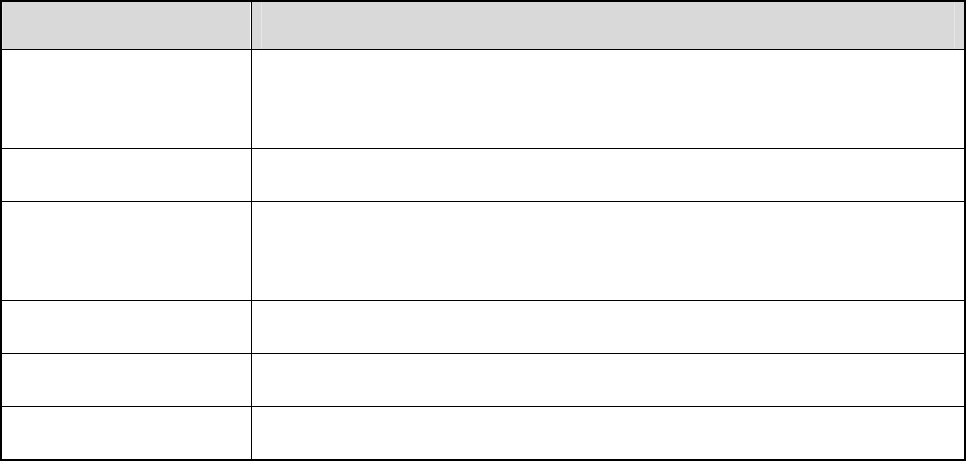
7. Alarm Information
The repeater will have real-time detection of its status automatically. When the repeater is operating
abnormally, the alarm indicator on the front panel will remain glowing red until all alarms are eliminated.
When an alarm event occurs, you can diagnose and handle the problem via the RDAC application
provided by us or contact your local dealer for technical support.
Alarm types and causes are listed in the table below:
Alarm Type Alarm Cause
External Power
Abnormal
High Voltage: The input voltage is higher than 15.8V±0.2V.
Low Voltage: The input voltage is lower than 11V±0.2V.
High Temperature Temperature sensor detects a temperature above 85℃.
Abnormal VSWR VSWR > 3:1.
Over-high VSWR will damage the PA module or even disable it.
TX Unlock TX PLL is unlocked, and the repeater stops transmitting and repeating.
RX Unlock RX PLL is unlocked, and the repeater stops receiving and repeating.
Fan Failure PA temperature is higher than the fan off temperature configured via CPS.
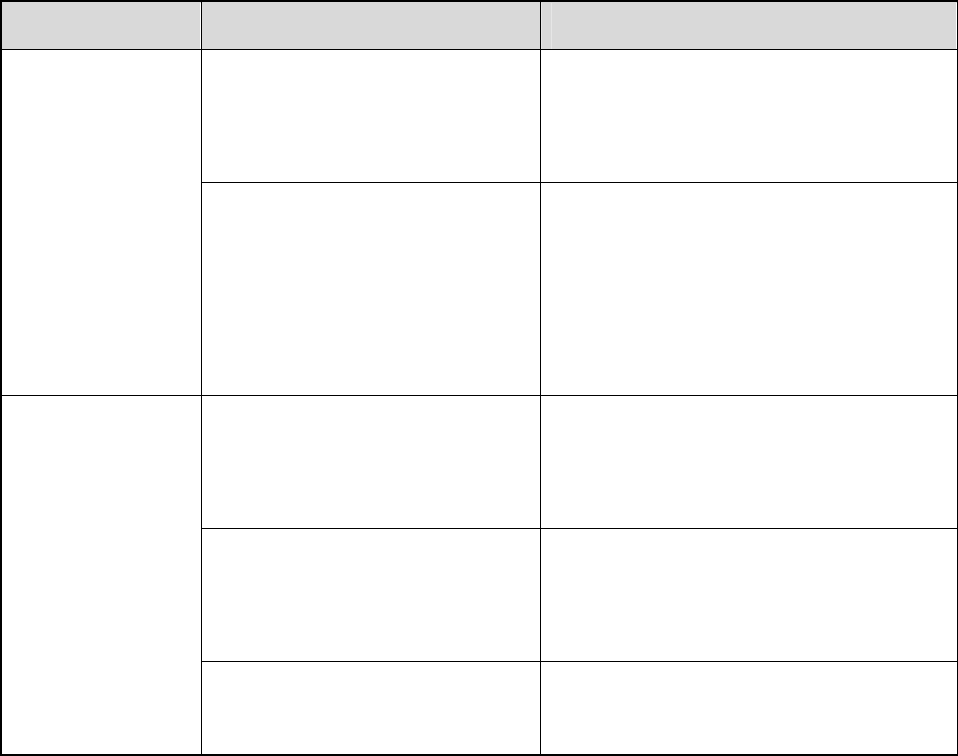
8. Troubleshooting
Phenomena Analysis Solution
Power-on Failure.
The power cord may be
unconnected or not securely
connected to the outlet.
Properly connect the power cord and
ensure secure connection.
The power supply may output
improper voltage.
Check if the power supply outputs the
voltage within the required range (DC
power supply: 13.6V ±15%; AC power
supply: 90V to 264V). If not, replace the
power adapter.
Unable to
communicate with
other members.
TX/RX frequency of the repeater
is inconsistent with that of
portable/mobile radios.
Check if the frequencies are consistent.
Reset the frequencies when necessary.
Failed to repeat useful signal due
to strong interference signals.
If you cannot remove or bypass the
interference source, change to operate at
other frequencies.
The group member is out of the
coverage of the repeater.
Move towards the coverage of the
repeater.
If the above solutions cannot fix the problems, or there are other questions, please contact Hytera or the
dealer for more technical support.

9. Care and Cleaning
To guarantee optimal performance as well as a long service life of the repeater, please follow the tips
below.
Product Care
z Keep the repeater in good environmental conditions to ensure reliability.
z Do not place other equipment on top of the repeater to ensure optimal heat dissipation.
z Do not pierce or scrape the product.
z Keep the product far away from corrosive environments.
z Do not place the product in corrosive agents, solutions or water.
Product Cleaning
Caution: Be sure to turn off the repeater before cleaning.
z Remove the dust and fine particles on the repeater surface with a clean and dry lint-free cloth or a
brush regularly.
z Use a non-woven fabric with neutral cleanser to clean the keys, control knobs, LCD and connectors.
Do not use chemical preparations such as stain removers, alcohol, sprays or oil preparations. Make
sure the repeater is completely dry before use.

10. Optional Accessories
Contact your local dealer for the optional accessories used with the product.
Caution: Use the accessories specified by Hytera only. If not, Hytera shall not be liable for any
losses or damages arising out of use of unauthorized accessories.